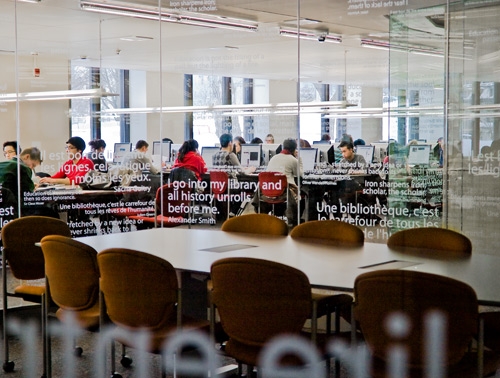Accessibility barriers are, unfortunately, part of the McGill University experience. Students at McGill have repeatedly reported a lack of silent study spaces on campus, and the closure of the Schulich Library and the University Centre—among other construction currently taking place on campus—exacerbates this problem. While the initiatives of on-campus advocacy groups, like the Arts Undergraduate Society’s (AUS) creation of McLennan’s “Tranquility Zone”, are commendable, we feel compelled to express some concerns about McGill’s accessibility barriers. In general, access needs for students with cognitive and physical disabilities are being overlooked. We are writing to ask McGill Administration that these access needs be prioritized, with the urgent recommendation that McGill implements more quiet spaces on campus. These issues are ongoing, and there are currently no short-term solutions for disability advocacy.
The students of COMS 411: Disability, Technology & Communication want to contribute to campus accessibility, which offers a place conducive to thinking about designing for disability. We did a survey of McGill’s current silent study and alternative spaces, reviewing each area based on specific design parameters. Based on our findings, the university’s conception of disability has been primarily concerned with spatial understandings of access and physical disability. The administration seems to understand intellectual disabilities and mental health as matters that do not require spatial considerations. However, these impairments do, in fact, require spatial accessibility policies. Intellectual disabilities, neurodiversity, and mental health are not one-dimensional, nor are they non-spatial. Accessibility goes beyond physical access to buildings, rooms, and washrooms, and has many different dimensions that need to be addressed to create truly accessible environments.
In our audit of the downtown campus, we evaluated light levels, acoustics, and chemical access, among other access categories, which are all crucial when designing accessible spaces. It is widely known that existing resources for students with cognitive and physical disabilities are sparse: For example, there are no quiet zones or rooms on campus that are specifically designed for students with disabilities. A quiet space is an area, zone, or room where one can access and evaluate their needs, rest, take a break, or relax. The absence of quiet spaces is an accessibility issue for students with cognitive disabilities and sensory sensitivities and should be built.
There has been an effort to make existing spaces more physically accessible, but the administration must consider a wider spectrum of access needs and design spaces with disability in mind from the very beginning.
Questions about accessibility issues from students are addressed superficially at best. Although the Office for Students with Disabilities (OSD) has implemented the Accessible Media Room on the first floor of the McLennan-Redpath library and has offered accommodations such as note-takers, McGill still must recognise that there are more important and long-term needs for students with disabilities. Put simply, the university needs to make accommodations to make McGill’s campus safe, comfortable, and usable for students with cognitive or physical disabilities. Part of the current issue is that if information exists, it is difficult to access or find on McGill’s various web pages. As such, we are currently designing an accessible website which will include a directory of resources for students’ well-being, and a map for silent spaces, lounges, and hubs on campus. We hope that, in the future, this website will be transferred to the Wellness Hub or to another centralized resource, rendering it a long-term and ongoing project.
“There has been an effort to make existing spaces more physically accessible, but the administration must consider a wider spectrum of access needs and design spaces with disability in mind from the very beginning.”
While the university has made efforts toward promoting greater physical accessibility such as installing wheelchair ramps, wide doors with push buttons, and spacious stalls in washrooms, there is still a long way to go. We recommend that any decision to design a quiet space or on-campus resource for students with disabilities be built with a resonant material, or materials designed for specific disabilities, and that any space on campus is designed for a range of disabilities and access needs. Students with disabilities should be consulted and included in the decision-making processes regarding the creation of accessible spaces on campus. Without the input of these individuals, the university administration will continue its pattern of neglecting an important membership of McGill’s demographic. It is crucial that McGill and its community continue communicating about access needs, carve out accessible resources and work together on issues of accessibility on campus.









